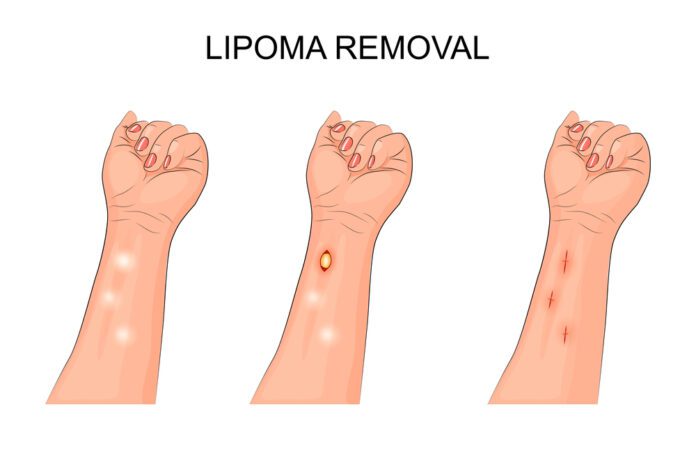Overview Of Lipoma
A lipoma is a noncancerous growth of fatty tissue cells. They can develop in almost any organ of the body, although they are most commonly found in the subcutaneous layer just below the skin. They usually grow slowly, and are non-painful masses that are soft and moveable under the skin. They can also be associated with other syndromes where they are not so harmless. In the rare disease adiposis dolorosa there is swelling of the body and fatty deposits (lipomas) which apply pressure to the nerves, resulting in weakness and sometimes extreme pain. The amount of discomfort, irritation, or pain from the growth depends upon where in the body and what surrounding tissue or organ are affected.
Types Of Lipoma
While all lipomas are made up of fat, there are subtypes based on the way they appear under the microscope.
Some varieties include:
- Conventional lipoma (common, mature white fat)
- Hibernoma (brown fat instead of the usual white fat)
- Fibrolipoma (fat plus fibrous tissue)
- Angiolipoma (fat plus a large amount of blood vessels)
- Myelolipoma (fat plus tissue that makes blood cells)
- Spindle cell lipoma (fat with cells that look like rods)
- Pleomorphic lipoma (fat with cells of all different shapes and sizes)
- Atypical lipoma (deeper fat with a larger number of cells)
Causes Of Lipoma
The cause of these growths is not completely understood. Some subtypes appear to have a genetic defect (conventional lipomas, spindle cell lipomas, pleomorphic lipomas), and may be inherited from family members.
There has been no proven connection between the development and any particular occupation or exposure to chemicals or radiation. Some doctors think that these growths occur more often in inactive people.
Symptoms
Lipomas are usually roundish masses that feel soft and rubbery. Growths just under the skin can be moved with gentle pushing. They do not typically hurt, although some of the subtypes can be painful, such as angiolipoma.
It often takes longer to notice growths that are in deeper tissue, and these tumors can be quite large when they are actually discovered. Deeper lipomas also tend to be less mobile.
Tests
Although doctors can usually diagnose lipomas based on history and physical examination alone, imaging tests can be helpful for some cases.
X-rays. Although these tests create clear pictures of dense structures like bone, plain x-rays can show a prominent shadow caused by a soft tissue tumor, such as a lipoma.
Computerized tomography (CT) scans. These scans are more detailed than x-rays and will often show a fatty mass to confirm the diagnosis.
Magnetic resonance imaging (MRI) scans. The best information for diagnosing lipomas comes from an MRI scan, which can create better images of soft tissues. MRI scanning will show a fatty mass from all perspectives. Oftentimes, doctors can make the diagnosis based on MRI imaging alone, and a biopsy is not required.
Biopsy. A biopsy is sometimes necessary to confirm the diagnosis of lipoma. In a biopsy, a tissue sample of the tumor is taken and examined under a microscope. Your doctor may give you a local anesthetic to numb the area and take a sample using a needle. Biopsies can also be performed as a small operation.
In most cases, a biopsy is not necessary to confirm the diagnosis. After the growth is removed, a biopsy will be done on a sample of the tissue.
Under a microscope, lipomas often have a classic appearance with abundant mature fat cells. Sometimes there can be a small amount of other cell types, too, such as cartilage or bone.
Liposarcoma. During the diagnosis phase, your doctor will work to differentiate a lipoma from a more aggressive form of fatty tumor called liposarcoma. Liposarcomas are cancerous. The symptoms of liposarcoma vary from those of lipoma. Liposarcomas typically grow quickly, are often painful, and are not as moveable.
People with lipomas are not more likely to develop a fatty cancer in the future. The exception is people with atypical lipomas. This subtype can turn into a liposarcoma, but this is rare.
Treatment Of Lipoma
Observation
Because lipomas are benign tumors, no treatment may be an option, depending on your symptoms. If you choose no treatment, it is very important that you see your doctor for regular visits to monitor any changes in the tumor.
Excision (Removal)
The only treatment that will completely remove a lipoma is a surgical procedure called excision.
Procedure. In this procedure, a local anesthetic is typically injected around the tumor to numb the area. Large lipomas or those that are deep may require regional anesthesia or general anesthesia. Regional anesthesia numbs a large area by injecting numbing medicine into specific nerves. General anesthesia puts you to sleep.
After the anesthesia is given, your doctor will make an incision in your skin and cut the tumor out.
Recovery. You should be able to go home soon after the procedure if it is a small or superficial mass. You will have a few stitches, which your doctor will remove within a couple of weeks.
How long it takes you to return to most daily activities will depend on the size and location of your lipoma. If you have any pain or discomfort, you may want to limit some activity. Your doctor will provide you with specific instructions to guide your recovery.
Recurrence. These growths are almost always cured by simple excision. It is unusual for a lipoma to grow back but, if it does recur, excision is again the best treatment option.



